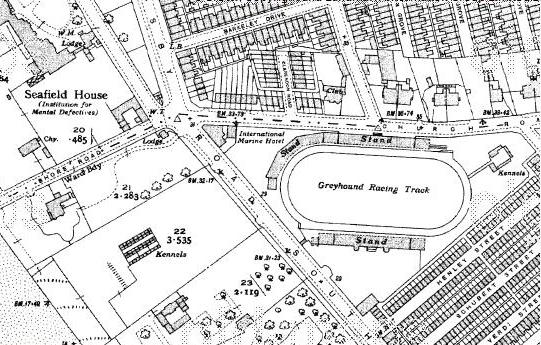Crosby Road South, Seaforth, Liverpool.
POSTCODE————————————L21 4PW
LOCATED————————————–Roughly four miles north of Liverpool city centre near Seaforth Docks, just off Crosby Road South with the venue running parallel along side Church Road in Waterloo.
ORIGINAL SITE——————————-Constructed on wasteland at the rear of the now unoccupied International Hotel on Crosby Road South.
DATE CONSTRUCTED———————-Around 1932.
DATE VENUE OPENED———————February 1933.
Meaning other sports may have taken place prior to the arrival of Greyhound Racing.
FIRST MEETING——————————25th February 1933.
Greyhound Racing only.
LICENSED OR INDEPENDENT————Operated under both codes on more than one occasion during its existence.
All venues covered would have to be licensed with the government, licensed suggested in this section would refer to tracks operating under NGRC Rules.
INSIDE OR OUTSIDE HARE TYPE——–Inside Sumner.
Please note that the Electric Hare suggested is only a guidance and would have been in operation for a certain amount of time at this venue. Although it is not necessarily guaranteed that it was operational all the time, as other types of lure may have been used and updated as time progressed.
DISTANCES————————————300 and 500 yards.
Please note that most racing venues distances had become varied throughout the years, the ones given above were at once point set and offers only a guidance to the track size.
CIRCUMFERENCE—————————Dont know.
Please note that alterations at most racing venues throughout its existence would see that the circumference of the track would vary, the one shown above offers only a guidance to the track size.
BIG RACE NAMES—————————None to mention.
STADIUM SHARED WITH——————Bootle Athletic Football Club who plated in the Lancashire Combination between 1948 and 1953. Also Speedway took place during the mid 1930’s.
LAST MEETING——————————-December 27th 1965.
Greyhound Racing only.
STADIUM CLOSURE DATE—————-As above.
Meaning other sports may have taken place after Greyhound Racing had ceased.
STADIUM DEMOLITION——————–Not clear but the stadium lay derelict for a number of years.
BUILT ON SITE——————————–Housing on Church Grove in Waterloo partially covers the site with the rest of the site having been landscaped.
In some cases, structure’s that originally covered the venue after the stadium had been demolished, may have been themselves demolished too, so the one described is more likely to be the one which now presently covers the site.
EVIDENCE LEFT TODAY——————-Nothing known of.
FURTHER COMMENTS——————–None





.
The Seaforth Greyhound Stadium was found roughly four miles north of Liverpool City Centre in a very industrious area close to the docks and became the fourth and last track to open in the city’s boundaries. The track was situated along Church Road in the district of Waterloo, set back behind the now vacated International Hotel, which today stands derelict alongside the A565 Crosby Road.
The stadium was constructed on open land in 1932, with its first meeting coming on the 25th of February 1933. Although beginning its existence as an NGRC track it reverted back and forth as an independent track a number of times during its lifetime. Although generally overshadowed by Liverpool’s more luxurious tracks at Stanley and White City, it sometimes lacked in attracting enough greyhounds to fill the card and often featured four dog races. It staged race distances of 300 and 500 yards, with the greyhounds chasing an inside Sumner type hare. September 1934 witnessed the arrival of Speedway Racing at Seaforth, but with the bends being too tight, the cinder track gave great concern regarding safety to its riders, seeing the venture last for just twelve months only before being withdrawn.
It also became the home to amateur football with Bootle Football Club hosting Lancashire Combination fixtures there between 1948 and 1953. In 1950 the Seaforth track opted out of NGRC racing and began operating as a flapping track for the first time with the hope of attract more entrants. But like most tracks the early 1960’s brought Seaforth’s demise, certainly due to poor attendances which brought on a last gasp effort to improve things by switching back to NGRC rules in 1964. But again the lack of interest, and the continuous soaring costs, contributed to the stadium being sold to developers, which in turn lead to Seaforth staging its final meeting on December 27th 1965.
Once closed the track lay derelict for a number of years before it finally became demolished, eventually making way for new housing. Today part of the site is covered by housing on Church Grove, with the rest of the site having been landscaped, which sadly leaves no evidence of the Greyhound Stadium, although sections of a concrete fence situated along Church Road may have been a boundary for the stadium’s car park.
A programme, photograph or even memorabilia for this track is required for this page, if you can help please contact me.

Recent Comments